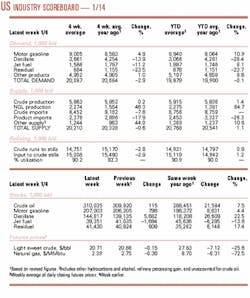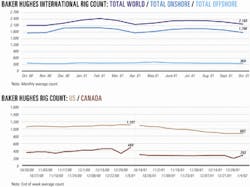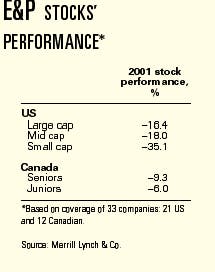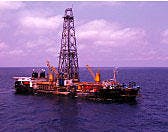Market Movement
EIA: Oil prices to rise
OPEC's decision to cut 1.5 million b/d beginning Jan. 1 is expected to gradually push oil prices up this year, according to EIA. The agency projected WTI prices will rise to $25-26/bbl by yearend and remain there through 2003.
EIA's oil demand projections for 2002 suggest worldwide demand growth of 800,000 b/d. With an anticipated recovery of the global economy by yearend, oil demand could increase by as much as 1.3 million b/d in 2003 over 2002 levels, with about half of this coming from the US, EIA said.
"For 2002-03, worldwide jet fuel demand is still assumed to be about 5-7% below what would have been expected prior to the Sept. 11, 2001, terrorist attacks," EIA added.
Statistics released by API showed US inventories of distillate fuel, including heating oil, increased by 5.7 million bbl to 144.8 million bbl last week.
US gasoline stocks also were up 798,000 bbl to more than 207 million bbl during the same period, while crude inventories increased 115,000 bbl to more than 310 million bbl, API noted.
API's report, said Lehman Bros. analyst Paul Y. Cheng, "should once again send a bearish signal to the entire petroleum complex given the unexpectedly large surge in middle distillate inventories.
"Looking ahead," Cheng noted, "absent any major supply disruptions, we expect product margins to remain sluggish throughout most of first quarter 2002 due to the fact that distillate inventories are currently 8.7% above the 1997-2001 average."
Lower natural gas price forecast
A sharp downturn in US natural gas-directed drilling probably will not reduce gas production enough to prevent low prices this winter and through most of 2002, EIA said.
Natural gas production increased 1.7% in 2001, while demand declined an estimated 5.3%, EIA said in its January forecast.
"We now expect [US] natural gas production to fall by about 400 bcf in 2002 (2.1%) and to recover to about 2001 levels in 2003," EIA said.
In December 2001, spot natural gas prices averaged $2.47/Mcf compared with a year-ago average of $8.36/Mcf.
For 2002, assuming normal weather and barring any major supply disruptions, the average gas price is projected to be $2.00/Mcf for the year, EIA said, blaming "sluggish industrial demand and robust underground storage levels." However, the expected rebound in economic growth will boost demand growth by 2%. Forecasters predicted spot gas prices will average $2.70/Mcf in 2003.
With gas demand projected to rise 1.2 tcf, or 5.5%, this year, EIA is expecting inventories to return to normal. EIA attributed 2001's decline in gas demand to weak fourth quarter heating-related demand. Heating season temperatures for most of that quarter were above normal, causing delays in storage withdrawals.
If temperatures are normal for the rest of the winter, the agency said, heating degree-days for the 2001-02 winter season would be 14% lower than last winter, EIA said.
Storage numbers reflect sluggish economy
Despite improved weather conditions, industry withdrew 0.124 tcf of natural gas from US storage for the week ended Dec. 28, 2001, said Ronald Barone, analyst with UBS Warburg.
US supplies are now at 2.86 tcf vs. 1.73 tcf last year. That compares with the prior 3-year average of 2.32 tcf and the prior 7-year average of 2.27 tcf for this time of year, Barone noted.
The latest year-over-year storage surplus hit a record high of 1.13 tcf, Barone said (see table).
"At this point, if one were to apply the average 7-year historical weekly withdrawal rate of 100 bcf going forward, Apr. 1, 2002, storage supplies would approximate 1.53 tcf vs. the prior 7-year Apr. 1 average of 0.946 tcf," he said.
Industry Scoreboard
null
null
null
Industry Trends
OIL SHARES weathered a brutal bear market and recession in 2001 without giving up all of 2000's gains, said energy research and consulting firm John S. Herold.
"Oil stocks beat the broad market again last year, albeit by a very narrow margin," said Herold's yearend investment review.
Reporting on 300 companies divided by sector, the report said the best performing groups were master limited partnerships (with a 41% increase in total shareholder return), refiners and marketers (up 20.9%), and royalty trusts (up 19.9%).
"Compensating for a lagging performance in 2000, Canadian integrated and diversifieds were up 19.7%, and mid-sized Canadian E&Ps rose 13.1%," said Herold.
"Russian and eastern European firms led the international integrateds to a 5.3% gain, while the large integrated oils eked out a 0.1% rise."
Stockholders of producing oil firms-half the companies included-had to be reconciled to an average 20% loss in 2001, however, after their shares had doubled in 2000.
Herold said that stocks of international E&Ps fell only 7.8%, while large Canadian E&Ps fell 14.0%, large US E&Ps fell 17.6%, mid-sized US E&Ps fell 23.5%, and small US E&Ps fell 29.4%.
The report said that, of the 15 peer group stocks in the study, pipelines and diversifieds fell 14.9%, drilling contractors fell 26.5%, and other oil service companies fell 27.1%.
ECONOMIC RECOVERY should come in second half 2002 predicts Merrill Lynch in its 2002 E&P outlook. The speed of that recovery will affect energy revitalization, the report said, adding that demand and spending discipline will remain critical issues.
In 2001, prices dropped for oil by 26% and for natural gas by 73% following the wild upward ride in 2000. "With WTI $21.01/bbl [post OPEC's latest 1.5 million b/d output cut] and natural gas $2.46/Mcf, wellhead realizations are well above the 1990s' averages of $19.50/WTI and $1.87/Mcf but well below 2000 or 2001 prices," the report noted (see table).
Watch for E&P hiccups ahead in terms of ceiling tests or impairments, Merrill Lynch said, but that will create buying opportunities. Consolidations should continue, although cash flow will be an issue in the near term.
In recent years, each new year has seen an energy stocks sell-down, causing E&P stocks to have "tough sledding in their first quarters," Merrill Lynch said.
Of the 33 North American E&P stocks tracked, only half have announced 2002 capital budgets, making the Merrill Lynch 2002 estimates "somewhat soft."
In looking at other 2002 trends, Merrill Lynch notes:
- Capital budgets will drop 20-25%, and the US will register a 1.5% production decline in 2002, "which will wipe out the storage overhang."
- Despite new technology, excessive exploitation and smaller-scale reserves will require higher rig counts to sustain output.
- Company consolidations could set records. More assets will be for sale in 2002, but E&P managements are now sensitive to debt and their ability to service it. Most companies tended to issue debt, not equity, in recent transactions.
Government Developments
UPCOMING INQUIRIES may influence whether certain US public lands will be made available for leasing.
Hearings are scheduled this week regarding further oil and gas leasing in Los Padres National Forest in central coastal California. The US Forest Service has 766,867 acres potentially available for leasing in the 1.78 million-acre forest extending from 40 miles northwest of Los Angeles to the Big Sur area south of San Francisco.
Under maximum leasing, a postulated 84 million bbl of recoverable oil could be found, most of it from areas adjacent existing oil fields in Monterey, San Luis Obispo, Santa Barbara, Ventura, and Kern counties, according to a new draft environmental impact statement (DEIS) that had been expected since 1997.
There would be no leasing in the Santa Ynez River watershed, nine wilderness areas, or the Big Sur coastal zone, however.
DEIS alternatives range from no new leasing to the drilling of up to 151 wells in 10-15 years, requiring 25 drill pads, 19 miles of road, and 17 miles of pipeline.
A final EIS is expected by midyear, after which the forest supervisor will decide on leasing.
Nominations for two Cook Inlet federal lease sales in Alaska are due to US MMS by Feb.14. MMS said the call for information does not indicate a preliminary decision to hold the lease sales; that determination will be made later. Currently, MMS has the sales on a tentative 5-year sale schedule, with Sale 191 slated for May 2004 and Sale 199 for May 2006.
The first sale would require at least 21/2 years for studies and determinations, MMS said, and less extensive studies for the second sale would focus on new issues or changes from the first study.
The proposed 5-year leasing program offers three options for leasing in the Cook Inlet area in 2002-07: two sales, one sale, or no sales.
The Cook Inlet area consists of 517 whole and partial blocks (about 2.5 million acres). Alaska also leases state tracts in the inlet.
CANADA on Dec.19 initiated a 60-day period of public comment on new Canadian regulations designed to reduce sulfur content in diesel fuel.
The regulations, aligned in timing and level with corresponding requirements in the US, would limit sulfur levels in on-road diesel fuel to 15 ppm-a 95% reduction from today's 500 ppm-enabling the introduction of advanced emission-control systems for buses, trucks, and other on-road diesel vehicles. The limit also would reduce emissions of sulfur dioxide and sulfates.
The reduced limit would take effect June 1, 2006, for producers and importers and Sept. 1, 2006, for sellers. Arctic regions would follow a year later.
Quick Takes
Oil and gas prospects in Africa continue to heat up, particularly in the continent's western and northern play areas.
Amerada Hess confirmed its Oveng oil discovery with an appraisal well in Oveng field on Block G off Equatorial Guinea.
Oveng-2,drilled with GlobalSanta- Fe's Glomar R.F. Bauer drillship, found 199 ft of net oil pay and 145 ft of net gas pay. Oveng-2 was drilled to 6,989 ft TD in 696 ft of water. Oveng-2 flowed 8,457 b/d of 34° gravity oil from an interval of 124 ft.
Amerada Hess's appraisal of the nearby Okume find, meanwhile, continues with the drilling of Okume-4, which lies just 1/2 mile west-northwest of the Oveng-1 discovery well. Oveng-1 was drilled in June 2001 and had 168 ft of net oil pay.
Oveng field is 12 miles northeast of Amerada Hess-operated Ceiba field, which began production in November 2000.
Amerada Hess is operator of Block G, in which it holds 85% working interest. South Africa's Energy Africa holds the remaining interest in the block. Equatorial Guinea carries a 5% participating interest in any Okume and Oveng area commercial production.
Elsewhere in Africa, Apache made two discoveries in Egypt.
The company's Ozoris-1X wildcat in the Western Desert found both oil and natural gas. The well, which is on the company's Khalda concession, flowed 2,504 b/d of 38.5° gravity oil and 750 Mcfd of gas through a 1-in. choke at 161 psi of flowing pressure from one of three zones.
The tested zone-the Cretaceous Alam el Bueib 3D sand-is a prolific producing horizon at Khalda Ridge, 12 miles east of Ozoris-1X. The discovery is 6 miles from the nearest well and 9 miles from the nearest field on the 2 million acre concession. Apache owns a 100% contractor's interest in Khalda.
"The pay zone tested was more than 1,500 ft downdip from the crest of the Khalda Ridge, one of the largest hydrocarbon accumulations in the Western Desert, yet still had good porosity and permeability," said Apache Pres. and CEO G. Steven Farris. "And we still have another 65 ft of potential pay to test in two additional uphole zones."
Also in the Western Desert, Apache completed another successful well on the South Umbarka development lease, in which it holds a 100% interest. On test, the Khepri 9 well flowed 29.5 MMcfd of gas and 220 b/d of condensate and was completed in the Alam el Bueib D-7 sand through a 1-in. choke with 1,640 psi flowing wellhead pressure from perforations at 13,340-68 ft. Apache will next test the D-1 sand, it said.
Khepri 9 is 1.2 miles southeast of the Khepri 1 discovery well. Natural gas production from the 106,253-acre development lease is transported 30 miles via pipeline to the company's Salam gas plant on the adjacent Khalda concession.
Meanwhile, Italian company ENI signed a production-sharing agreement with Nigerian National Petroleum Corp. (NNPC) for Block 244 off Nigeria. ENI affiliate Nigeria Agip Exploration operates the block with 90% interest, and partner Nigerian Production Development Co. (NPDC), a unit of state-owned NNPC, owns the remainder.
The companies plan to conduct a seismic survey and drill two exploration wells. Block 244 is 200 km south of the Brass terminal in 1,500-3,000 m of water.
"This initiative represents a further opportunity to consolidate ENI's activities in Nigeria," ENI said, noting it is working on a series of projects to exploit Nigerian associated gas reserves, including gas liquefaction plants and power generation plants. ENI has been operating in Nigeria since 1962 and has hydrocarbon equity production of 110,000 boe/d.
Syncrude production from the $4.2 billion Sincor project in Venezuela will start up on schedule in February, said TotalFinaElf, a main project shareholder.
Construction work at the upgrader in Jose was completed at yearend and start-up is now under way.
Sincor-formally known as Sincrudos de Oriente Sincor CA-operates this project to produce 8.5° gravity crude, transporting it by a 200 km pipeline to Jose, and upgrading it to a 32° gravity crude for export (OGJ, Oct. 29, 2001, p. 47).
At a production plateau of 200,000 b/d of heavy crude, the upgraded syncrude will reach 180,000 b/d of "Zuata Sweet."
TotalFinaElf holds 47% interest in Sincor; other partners are Venezuela's PDVSA 38% and Norway's Statoil 15%.
Since initial production of heavy crude from that field began in December 2000, more than 15 million bbl of extra-heavy crude oil has already been produced and blended with lighter crude oil to obtain a 16° gravity crude oil for export.
With the completion of the Jose upgrader, the entire integrated chain will now be gradually started up. The contract duration is 35 years.
In other production news, ENI unit Agip Energy & Natural Resources started production from Okono field on OML 119 in 100 m of water off Nigeria. Agip and partner NPDC earlier this year let a $356 million contract to a joint venture of ENI unit Saipem and Single Buoy Moorings to supply, install, and operate two floating production, storage, and offloading vessels to be used on Okono and nearby field Okpoho (OGJ Online, Sept. 7, 2001). NPDC will take 30% and Agip 70% for the first 5 years, after which the ratio will change to 40:60 (OGJ Online, Sept. 14, 2000).
Several Pipeline projects have received FERC approval.
The commission has approved the Maritimes Phase III and Algonquin HubLine gas pipeline projects.
The Phase III and HubLine projects would connect the 650 mile Maritimes pipeline with the 1,000 mile Algonquin Gas Transmission system to transport gas off eastern Canada to the northeastern US (OGJ Online, Oct. 13, 2000). FERC recently approved a final environmental impact statement for the two pipelines (OGJ Online, Nov. 30, 2001).
Joint venture Maritimes & Northeast Pipeline would extend the existing Maritimes system with 25 miles of 30-in. line from Methuen, Mass., to Beverly, Mass., where it would connect with Algonquin Gas Transmission HubLine project. Algonquin, a unit of Duke Energy Gas Transmission, would build the HubLine project, a 30-mile, 24-in. offshore gas line extending from Beverly to Weymouth, Mass.
The project also includes 5 miles of 16-in. offshore lateral. Maritimes is owned by affiliates of Duke Energy 37.5%, Westcoast Energy 37.5%, ExxonMobil 12.5%, and Emera 12.5%.
FERC also has given Islander East Pipeline a positive preliminary determination to build, own, and operate 50 miles of gas pipeline in Connecticut and on Long Island, NY.
In addition, FERC approved a companion application by Algonquin to increase throughput for more than 13 miles of existing pipeline and build a new compressor station in Cheshire, Conn.
The 24-in. Islander East pipeline-which is owned equally by units of KeySpan Energy and Duke Energy-is expected to provide 260,000 dekatherms/day of gas and to be in service by 2003.
In the preliminary determination, FERC said the Islander East and Algonquin proposals are in the public convenience and necessity because they will serve expected market growth. FERC also said the Islander East project would increase the reliability and flexibility of the interstate pipeline grid.
Final approvals and construction certificates are dependent on a favorable environmental review. FERC staff will be studying the environmental impacts of the project and issuing a draft EIS in the near future.
Islander East will extend from Connecticut across Long Island Sound to Wading River, NY, with proposed connections to KeySpan's Long Island delivery system. Algonquin is proposing upgrades for 13.7 miles of existing parallel lines in Connecticut, plus the new Cheshire compressor station.
In addition, FERC has granted interim approval for the US portion of the $1.35 billion (Can.) Millennium pipeline project, which would transport Canadian and US natural gas to the Northeast, primarily to the New York City area.
It has granted a certificate of public convenience and necessity to Millennium Pipeline Co. and Columbia Gas Transmission, which propose to build and operate 424 miles of interstate pipeline, compressor stations, and related facilities between the Canadian border near Lake Erie and Mount Vernon, NY.
The proposed 551-mile line from Dawn, Ont., to Westchester County, NY, has been opposed by residents of Mount Vernon who complained the route is too close to parks and schools.
FERC has called on residents and officials of Mount Vernon to seek an alternate route near the city for the pipeline. If no agreement is reached within 60 days, FERC will issue an order covering that portion of the line at a later date.
The commission added a number of conditions to the certificate to mitigate any adverse environmental impact. FERC ordered that the Millennium line begin service within 2 years.
In August, TransCanada PipeLines and St. Clair Pipelines withdrew their applications with the Canadian National Energy Board to construct and operate the Canadian portion of the Millennium Pipeline, citing regulatory delays. However, the companies have now decided to reapply, because FERC granted a petition for the US portion of the line.
OxyVinyls, a unit of Occidental Chemical, is citing "current market conditions" as the main driver behind a decision to idle its Deer Park, Tex., chlor-alka* facility.
The plant, which has a production capacity of 410,000 tonnes/year of chlorine and 451,000 tonnes/year of caustic soda, will be brought back online "when warranted by market conditions," the company said.
"During the period of suspended operations, OxyChem will supply OxyVinyls with an equivalent volume of chlorine from other facilities and will continue to meet all customer requirements," OxyChem said.
Operations at OxyVinyls's other Deer Park facilities producing vinyl chloride monomer, polyvinyl chloride, and anhydrous caustic soda will not be impacted by the closure, the unit said.
Topping refining news, Phillips Petroleum signed a licensing agreement with Conoco for the application of Phillips's S Zorb Sulfur Removal Technology (SRT) for gasoline at Conoco's refineries. The two firms recently agreed to merge.
The licensing agreement includes an option for Conoco to use S Zorb SRT at one or more of Conoco's four US refineries and one refinery in England. The Conoco license is one of four major license agreements for S Zorb SRT, which is currently licensed for use at 15 refineries in and outside the US.
"We're seeing refiners continue to carefully review sulfur removal technologies, taking into consideration both economic and performance issues," said Brian Evans, manager of Phillips's fuels technology division.
Phillips's S Zorb SRT was developed to help oil companies comply with US EPA's Tier II and the European Commission's Auto/Oil sulfur limits.
A 6,000 b/d plant at Phillips's Borger, Tex., refinery complex has demonstrated the technology's ability to reduce gasoline sulfur content to levels below 10 ppm (OGJ, Sept. 10, 2001, Newsletter, p. 8).
In other refining news, Nigeria plans to seek international bids for the construction of new refineries as part of its liberalization of the downstream sector. OPEC News Agency reported that Funsho Kupolokun, special assistant to Nigeria's president on petroleum matters, said the government hopes to license about five refineries with a capital outlay of not less than $1.8 billion. Two private firms previously were licensed to build refineries, but those projects have yet to get under way. Kupolokun said the Department of Petroleum Resources would call for tenders for the import of petroleum products later this month. He said cargoes of oil products could be landed at Calabar, Port Harcourt, and Warri, and the additional supplies would reduce fluctuations in fuel prices. Kupolokun said the government plans to divest its interest in the Petroleum Equalization Fund, which it uses to regulate prices for NNPC. He said, "Everybody is fed up with monopoly, and everybody believes that liberalization is the answer. What serves the interest of everybody today is to move away from monopoly and have freedom of choice."






